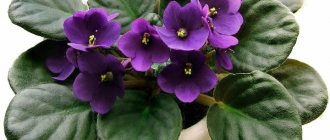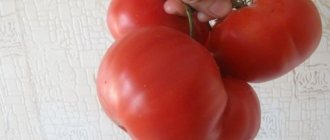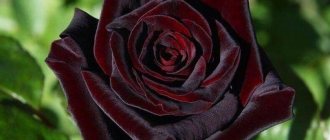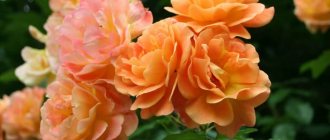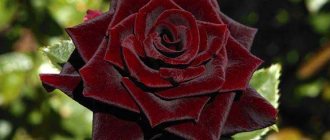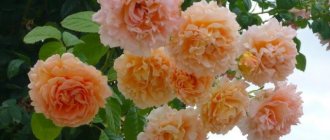Description and history of the variety
The blooming climbing rose Rosarium Jutersen is a delight. The bushes are abundantly strewn with large scarlet flowers with a pink tint, which bloom on the shoots of last and this year.
The variety grows in height and width, occupying a large space, it rarely gets sick and is almost not damaged by pests. The leaves are dark green, glossy, the height of the bush is 1.2-2 m, in warm climates the vines grow up to 3.5 m. The variety tolerates pruning well, the plant can be grown as a bush.
The climbing rose Rosarium Jutersen belongs to the branched climbers. It stands out for its large, double flowers, collected several times in large brushes. The first flowering is abundant, then with short breaks it repeats until frost.
General information about climbing rose
A distinctive feature of climbing roses is the shoots that curl and can reach a length of up to several meters. If there is any support near the bush of this rose, it will quickly be captured by the long and flexible branches of the flower.
Thanks to this feature of the climbing rose, it can be used to decorate any garden structure or vertically green a building, plant walls or pergolas. In addition, these roses have a very diverse range of colors, so they can be used to play up your garden design in an interesting way.
Note! The size of flowers in climbing plants ranges from 2.5 to 12 cm in diameter. Flowering is abundant and repeated, beginning in June and continuing as long as the weather is warm (depending on the variety, the flowering period can range from 30 to 170 days).
Among climbing roses there are both once and repeatedly blooming species. The species that bloom repeatedly include the Uetersener Klosterrose rose, which also belongs to the climber class. The Uetersener Klosterrose has soft pink, cup-shaped flowers and a light rosehip scent. The height of the bush reaches from 2.5 to 3 meters.
Additional Information! Another decoration of the garden are grandiflora roses. Grandiflora is a new garden group, which was created in 1946 by Walter Armstrong, a famous breeder, by crossing a floribunda rose (the Floradora variety was taken as the basis) and a hybrid tea (Charlotte). It can reach 2 meters in height. It has excellent resistance to cold and fungal diseases. The colors of this garden group are the most varied and bright.
Origin of the variety
"Rosarium Utersen" belongs to the second generation of kordesii hybrids, created by specialists from a German family company specializing in the selection and production of roses. Bred in 1957 by crossing the Karlsruhe rose and an unknown seedling, officially registered in 1977.
In the photo - Karlsruhe, which served as the parent form for the creation of the "Rosarium Uetersen"
The variety has been awarded many awards received at prestigious international exhibitions in Wales, Arkansas, Jacksonville, Illinois, Seattle, Southampton, etc. (1999-2001).
World rose awards Rosarium Jutersen
The variety gained wide popularity among gardeners in the 90s. Climbing roses are back in fashion. Thanks to its unique decorative qualities and other positive characteristics, the Rosarium Utersen variety has received many awards.
In 1980, the climbing rose was noted in New Zealand. The variety received the South Pacific Gold Star, the highest award among New Zealand breeders.
In 1999, Rosarium Utersen received numerous awards from the American Rose Society. The variety is nominated as the best climber. Similar awards were awarded at various exhibitions of the American Rose Society in 2000-2001.
Variety varieties
Rosarium Uetersen is a rose with large flowers from the German collection. The variety was created by crossing the Karlsruhe rose with an unknown seedling in 1957. This crossing was achieved by Reimer Cordes, one of the founders of the rose breeding and production company Wilhelm Cordes and Sons.
The name of the variety is dedicated to the Uetersen rose garden, which is one of the largest and oldest in Germany. The variety received its registration in 1977. There are two variations of it:
- Rose Uetersens Rosenprinzessin - has double, soft pink flowers that bloom throughout the season. A powerful and vigorous plant reaches a height of 150 cm. The size of the entire bush is 150×100 cm. Uetersens Rosenprinzessin is a rose with very strong shoots. The leaves are medium-sized, glossy, dark green in color;
- Rose Uetersens Rosenkonigin - has dense double flowers of salmon-red color. Each bud has up to 75 petals. Uetersens Rosenkonigin is a lightly scented rose. Rose Eutersens Rosenkonigin blooms profusely, right up to frost. During the period of mass flowering, there are from 5 to 10 flowers on one peduncle.
Description of the variety Rosarium Jutersen
The rose variety Rosarium Jutersen has excellent immunity. The plant practically does not get sick and tolerates frosty winters and rainy weather. The first flowering of the variety is very abundant, subsequent ones after breaks are slightly reduced. The shrub is strong but sophisticated.
| Color | Deep pink with silver highlights |
| Number of flowers per stem | From 3 to 5 |
| Aroma | Average |
| Flower size | 9-12 cm |
| Bush height | 200-350 cm |
| Bush width | 200 cm |
| Frost resistance | Frost-resistant, zone 5 |
| Powdery mildew resistance | Very good |
| Black spot resistance | Very good |
| Rain resistance | Very good |
| Bloom | Reblooming |
| Bush shape | Semi-spreading |
| Flower | Dense double |
Appearance and features
Rose Rosarium Utersen is lush, densely double, with about 100 wide, thin petals in one bud. The color of the rose is a delicate, rich pink. The reverse side of the petals has a light silvery sheen, which adds volume and brightness to the flower.
The filling is dense, making the buds wavy and fluffy. The petals are turned outward, the plain core is open. The shape of the buds is nostalgic, reminiscent of ancient roses that were in fashion two or three centuries ago.
The flowering shrub at its peak resembles a bright pink cloud because the stems are completely covered with large flowers. Towards the end of flowering, the buds change color and become darker, emphasizing the beauty of the new roses.
In favorable conditions, the breaks between flowering are almost imperceptible; young buds appear before the old ones have completely faded.
The shrub variety Rosarium Yutersen is tall, grows up to 3.5 meters, can be pruned to 2 meters and below. The perennial can be grown as a climber or shrub with a certain length and placement of the crop.
The branches are thin, elastic and flexible, easily supporting 3-5 large buds. Numerous shoots are covered with bright, dense foliage with a glossy finish and thin veins. The bush is very prickly. Roses have a distinct fragrance, reminiscent of sliced fruit.
Bloom
Rosarium Jutersen flowers are distinguished by their large size and increased doubleness. Their shape is often compared to English roses bred by David Austin.
The first (main) wave of flowering occurs in June and is characterized by abundance - one shoot can simultaneously bear up to 40 flowers, collected in inflorescences of 3-7 pieces. Later, until mid-September, single flowers appear.
During the period of abundant flowering, practically no leaves are visible on the bushes, and the shoots droop slightly under the weight of the inflorescences
A rounded, pointed bud opens into a cup-shaped flower, which later takes the form of an almost flat rosette and reaches a diameter of 12 cm. A densely double flower rosette consists of a large number (about 100) petals tightly adjacent to each other. The petal is satiny-delicate, slightly wavy, dark pink in color with a silvery tint on the underside. As the flower opens, the petals fade slightly and the color becomes less intense. The flowers have a delicate, faint aroma with pronounced sweet notes of apple and wild rose.
Origin of the variety
"Rosarium Utersen" belongs to the second generation of kordesii hybrids, created by specialists from a German family company specializing in the selection and production of roses. Bred in 1957 by crossing the Karlsruhe rose and an unknown seedling, officially registered in 1977.
In the photo - Karlsruhe, which served as the parent form for the creation of the "Rosarium Uetersen"
The variety has been awarded many awards received at prestigious international exhibitions in Wales, Arkansas, Jacksonville, Illinois, Seattle, Southampton, etc. (1999-2001).
Main characteristics
Let's consider the key features of the variety given in the table:
| Parameter | Characteristic |
| Culture | Rose (Rosa L.) |
| Variety | Rosarium Uetersen |
| Garden group | Cordes hybrids (Kord.) - modern climbing roses |
| Form | Bush |
| Life cycle | perennial |
| Purpose | Decorative |
| Reproduction | Vegetative (by cuttings and rooting of branches) |
| Bush height | Up to 3.5 m |
| Flowering type | Repeat flowering (remontant) |
| Flowering period | June – September |
| Type of flower | Dense double |
| Number of petals | 100 |
| Flower diameter | 10-12 cm |
| Petal coloring | Dark pink |
| Disease resistance | Above average |
| Frost resistance | Up to −28 ℃ |
| Registration in the State Register | Absent |
The plant amazes with its abundant flowering and splendor of inflorescences
Growing conditions
Since Rosarium Jutersen is one of the winter-hardy varieties, it can be grown not only in the southern, but also in the central regions, where the temperature in winter drops to -30 °C.
This is a light-loving plant, so it is recommended to plant roses in a well-lit area of the garden, making sure that the place is protected from drafts. But stagnation of air around the plant is also not desirable, so if you are planting several bushes, there should be a distance of at least 0.5 m between them, and the area should not be completely windless.
Yutersen does not like stagnant water in the soil, so it is better to avoid low-lying areas where groundwater comes close to the surface. If you plant a rose next to the house, then the distance to the foundation should be at least 50 cm. It is recommended to retreat at least 1 m to other shrubs with a developed root system.
Advantages and disadvantages of the variety
The climbing rose Rosarium Jutersen tolerates drought well. It quickly adapts to unfavorable, rainy weather, its flowers almost do not fade in the sun and always look wonderful. The variety is resistant to frost, common diseases, and easy to prune.
Disadvantages include sharp thorns on strong stems, which complicate care, and the need for winter shelter.
Advantages and disadvantages of the variety in comparison with other varieties
Rose Jutersen has many virtues. Among them, we can highlight, first of all, good disease resistance, as a result of which it will cause little trouble when caring for it. The flower also has good endurance in bad weather: rain or strong wind. Boasts high endurance in low temperatures. And of course, its advantages include its abundant flowering and beautiful bud color.
The flower also has disadvantages, but there are not so many of them. Rose Utersen has a weak aroma, its shoots grow slowly and it itself is very prickly.
Rosarium Utersen is a good option for those who want to decorate their garden with climbing pink shoots. It will be a wonderful decoration for arches, gazebos or even the walls of a house.
Characteristics of a rose
Jutersen stands out for its large flowers. Large brushes grow on the branches, ending in coral-pink roses. The backs of the petals are covered with a faint silvery-pink tint.
The plant is tall. In good conditions it often grows up to 3.5 m. The stem is thick and evenly studded with medium-sized thorns. The spikes are very sharp and create a lot of inconvenience.
The leaves are glossy, dark green in color. What distinguishes Yutersen from other climbing roses is that the variety has large flowers unusual for this species. The diameter of the buds can reach 12 cm, and the sum of petals in one flower is more than 100 pieces.
One brush can form up to 5 buds. The smell of the bud is somewhat reminiscent of a mixture of a fresh apple and a wild rose.
The first flowering of Rosarium Jutersen is the most abundant. During the first flowering, one bush can form up to 40 buds, which is a good indicator for Rosaceae.
Yutersen blooms so abundantly that sometimes green leaves are not noticeable under the buds.
Yutersen is a unique rose, it is grown as a climber or as a scrub.
The plant adapts well to unfavorable climatic conditions and tolerates heavy planting and strong winds.
Climbing rose Rosarium Jutersen in landscape design
In order for the Rosarium Jutersen climbing roses to look as decorative as possible, you need to choose the right environment for them in the flowerbed. They create a bright accent that can be successfully used in landscape design. In spring, a flower bed with roses looks sad, there are no flowers and after winter shelter many shoots are cut off. In summer it is also advisable to fill the gaps between flowering times.
There are plants that go very well with climbing roses Rosarium Utersen:
- Sage creates a wonderful bluish background for climbing roses and blooms until October if pruned.
- Catnip is blue to dark purple in color and varies in height.
- Lavender angustifolia. It is better to choose such a partner for climbing roses in warm climates.
- Gypsophila looks great with roses. A plant with small white or pink flowers, reminiscent of lacy clouds during flowering. Together with the climbing rose Rosarium Jutersen, a tall variety of gypsophila will look good.
- Meadow geranium. She has single, simple flowers, different varieties. The hybrid Rosanna is interesting; it blooms from May to October, growing in a wide soft lilac carpet.
- Heuchera blooms from May to October, keeping the flower garden with climbing roses beautiful even when the first frosts begin.
- Maiden's chamomile with small white flowers looks good next to climbing roses.
- Cuffs - unpretentious small flowers of yellow-light green color highlight the beauty of rose bushes.
- The bells are white and blue. One of the most unpretentious is the Rapunzel bell; it grows into a lush bush.
- Lilies blooming while climbing roses are resting.
- White double jasmine, tree hydrangea, small-flowered and large-flowered clematis serve as an excellent background for roses.
Decorative conifers, wormwood, and spirea look good next to the climbing roses Rosarium Jutersen. These plants create a wonderful backdrop for colorful flowers. In spring, an empty flowerbed with climbing roses can be filled with blooming bulbous roses. It is best to choose crocuses, muscari, and irises with small foliage and bright flowers. They take up little space and do not make caring for climbing roses difficult.
Pros and cons of the variety
The rose has a lot of advantages, which is why it is loved by many flower gardeners around the world:
- Has a strong immune system that protects against most diseases.
- Grows well in conditions of constant rainfall.
- Blooms beautifully in both sun and partial shade.
Along with that, there are several disadvantages. These include:
- Too many thorns. Working with Yutersen is terribly inconvenient, as there are many thorns and they are very sharp.
- The stems often bend to the ground, which is why it is necessary to build a strong support.
- This is a heat-loving plant that is afraid of winter frosts.
Reproduction methods
The variety of climbing rose Rosarium Jutersen propagates well from cuttings. Flowering and blind shoots with a heel are suitable for cuttings. They develop a good root system. The cuttings are rooted in an earthen substrate, having previously been kept in a root formation stimulator.
Climbing roses grown from cuttings are transplanted into the garden in the fall a month before the onset of cold weather. They winter well in open ground under cover. Even if it freezes, strong varietal shoots will emerge from the roots.
Plant propagation
You can get new climbing rose seedlings using cuttings. To do this, at the beginning of summer, young shoots should be cut 0.5-0.7 cm thick and divided into parts 15-20 cm long. When planting, the lower pair of leaves must be completely removed and the upper pair shortened by half to maintain sap flow.
To create favorable conditions, you should build a mini-greenhouse, and water and ventilate the seedlings throughout the season. They can be transplanted to a permanent place only after a year.
This rose is easily propagated by cuttings
Growing roses Rosarium Jutersen
The planting method depends on the type of seedling. It can be grafted and self-rooted, in a container or with an open root system. Bare-rooted seedlings are soaked in water for at least 2 hours before planting. For additional stimulation, soaking with humates or “Kornevin” is used.
Landing dates
Climbing roses Rosarium Jutersen are most often planted in open ground in the spring. The air and soil should warm up well by this time. The approximate planting time in central Russia is the end of May - the beginning of June, in the southern regions a little earlier.
Landing Features
Rose gardeners have noticed that Rosarium Yutersen blooms best when planted in a south or southeast facing position. In addition, it is advisable to choose a place so that the bush is not exposed to northern winds.
We recommend reading: “Description of the Polka rose”
On average, the plant grows by 4-5 m2, so leave at least 50 cm between the bushes.
Planting hole dimensions:
- Depth – at least 50 cm.
- Width – 40-50 cm.
The plant prefers fertile soil. Therefore, the planting hole must be fertilized with humus or compost. This feeding should be enough for 2-3 years.
Rules for caring for roses Rosarium Jutersen
In order for the rose garden in the garden to delight with beautiful flowers, the plants need constant care. Pink climbing roses Rosarium Jutersen should be given special attention:
- water;
- loosen the soil;
- remove weeds;
- feed.
And also mulch the tree trunk circle with compost. Be sure to trim the bush every year and carry out preventive treatments against pests and diseases.
Watering
The climbing rose Rosarium Jutersen most needs watering after planting and during flowering. In summer, in hot and dry weather, the bushes are watered 2-3 times a week, thoroughly soaking the soil in the circle around the trunk. The next day, the wet soil is loosened so that a crust does not form on its surface, preventing the roots from breathing. You can mulch the soil around the bushes with humus or well-rotted horse manure.
Top dressing
The first fertilizer is applied before planting. To do this, prepare the soil in advance by adding ash and compost to the site. The next important period is spring. Climbing roses Rosarium Jutersen especially need feeding at this time. It is best to use nitrogen and phosphorus fertilizers: urea or urea and superphosphate (10 g for each bush). At the same time, add compost or well-rotted manure.
During the year, 3 types of feeding are used for climbing roses:
- dry – compost;
- liquid - Green Boom fertilizer or other;
- granular - Green Boom granules.
Starting in July, nitrogen fertilizing is stopped.
Advice! During flowering, climbing roses need potassium; it is found in complex fertilizers and potassium nitrate.
Mulching
Experienced summer residents advise mulching the rose to maintain soil moisture and prevent the appearance of weeds.
- Before the procedure, remove weeds and weed the ground.
- Cover the bushes with a layer of mulch of at least 5 centimeters. Over time, it will turn into humus.
- Then mix the mulching material with the top layer of soil.
- Cover with mulch again.
Sawdust and dry grass are used as mulching substances for roses.
Trimming and shaping
You can use a trellis, steel pegs or arches as a support for the climbing rose Rosarium Jutersen. Pruning is an important part of annual maintenance. In order for the climbing rose Rosarium Jutersen to bloom over the entire height of the bush, it is best to carry out combined pruning.
Process description:
- thin and weak shoots are cut short in spring;
- strong branches are shortened by half their height;
- the most powerful whips do not touch.
With this method of pruning, the shoots will be of different lengths, and in the summer the buds will bloom from the base of the bush to the very top.
Rationing
The plant needs regular rationing. The purpose of rationing is to create an ideal crown. During pruning, excess branches that interfere with natural aeration are removed.
Standardization helps improve the quality of flowering. The mature plant produces more buds.
Yutersen's spring pruning begins with the removal of frostbitten branches. In the future, the growth of the bush is monitored. If the shoots spreading near the bush grow up to 70 cm, then it is necessary to build a support for them.
If Yutersen blooms only once per growing season, then the “waste material” is removed, allowing new shoots to grow.
If the shoot blooms more than once, then it is left.
Young shoots can be removed without hesitation if it seems to you that the bush is overloaded or overgrown. But you need to be careful with old shoots. They are removed only in extreme cases.
Protection from diseases and pests
In order for the climbing rose Rosarium Jutersen to grow and bloom well, it must be healthy. Numerous pests increase their activity in late spring:
- The most common pest of climbing roses is the rose aphid. You can get rid of it using folk remedies, for example, nettle infusion.
- The descending rose sawfly is also dangerous. His presence is revealed by drooping shoots. It is difficult to fight an insect that eats shoots from the inside. Spring preventative treatment with insecticides is useful.
- Weevils gnaw the buds and lay eggs in them. Wilted buds must be collected and the bushes sprayed with insecticides.
In addition, thrips, rose leafhoppers, and spider mites parasitize climbing roses. Preventive spring spraying with insectoacaricides is effective against all types of pests.
Various diseases can be more dangerous than insects:
- black spotting - for prevention, bushes are sprayed with the preparations “Skor” and “Topaz”;
- downy mildew and late blight - Ridomil Gold is used to combat the disease, the affected shoots are cut off and burned;
- powdery mildew - an effective method of control is treatment with wood ash, the leaves are moistened with water, sprinkled with ash powder for 2 hours, then washed off well.
Often diseases and pests are brought into the garden along with new seedlings, and then they try for a long time and unsuccessfully to get rid of them. To prevent this from happening, immediately after planting the seedlings are treated with fungicides and insecticides.
Preparing for winter
Yutersen is a heat-loving flower that is afraid of winter frosts. Therefore he needs shelter.
Over the course of a season, it can form up to 3.5 m of new stems, which need to be looked after in winter. In winter, shoots need to be properly protected from frost. This is done using a thick film in which the flower stems are wrapped.
They begin to prepare the flower for winter at the end of summer. In August, they stop loosening the soil near the flower and completely eliminate the application of nitrogen-containing fertilizers. Also, the plant is watered less often.
They begin to cover the rose when the air temperature drops to -5 degrees Celsius. You can’t cover the flower earlier. A light frost will strengthen the plant, but wrapping it up earlier can only cause decay and rotting.
They begin to cover the rose in dry weather. The stems are removed from the supports and cleaned. Dead shoots are removed. Afterwards, healthy branches are wrapped with wire or rope and pressed to the ground. The soil is first covered with spruce branches (dry branches of evergreen trees).
Shelter for the winter
In the autumn, before the onset of frost, the shoots of the climbing rose are removed from the support, trimmed a little and bent to the ground. An air-dry shelter is built on top. When the temperature drops to -5 °C, covering material is pulled over the frame.
Important! In cold climates, the climbing rose Rosarium Jutersen overwinters under a double layer of spunbond. Oilcloth is also used to cover young seedlings so that they do not get wet.
Pests and diseases
The described variety of climbing roses does not suffer from powdery mildew and black spot. It is extremely rare that a flower can be affected by rust or gray rot.
Important! If signs of fungal diseases are detected, the plant should be treated with Bordeaux mixture.
Diseases develop due to the fact that the bush is placed in a poorly ventilated place. If overwatered, the roots may begin to rot. It is recommended to remove the affected plants from the soil, carry out antiseptic treatment and replant them.
For prevention, climbing roses are sprayed with fungicides in spring and autumn. It is best to use biological preparations (Fitosporin, Fundazol, Trichodermin, Planriz). They are harmless to bushes and at the same time destructive to fungal and viral infections.
The Rosarium Utersen variety can be affected by pests:
- aphid;
- pennies;
- spider mite;
- rose cicada;
- leaf rollers;
- thrips.
When attacked by insects, the buds of a climbing rose begin to fall off, and curled and dried leaves appear. The plant loses its natural color. Insecticides and available folk remedies are used to control pests.
When the roots are damaged, the bush gradually withers and dies.
Useful tips
- The Rosarium Uetersen variety will bloom profusely if the root system is completely healthy. Before planting, the roots must be processed and trimmed, leaving a length of about 25 cm. Afterwards, the roots must be placed in a growth stimulator dissolved in water for 5-6 hours;
- Young shrubs need to be fertilized frequently, alternating nitrogen and mineral fertilizers. For the first three years, the plant needs to be fertilized 4 times per season. An older plant can be fertilized twice per season;
- It is recommended to handle thorny bushes only with rubberized gloves to avoid injury from sharp thorns;
- When choosing a seedling during purchase, you need to pay attention to its appearance. It is better to choose a seedling with a thick neck at the root; the color of the stem at the roots should be green, not gray. The seedling must have at least three healthy shoots, and the roots must also be healthy.
Pests
Mole crickets have appeared in the garden, this is very dangerous for your flowers, find out how to get rid of the pest
Medvedka
Several sources of foamy liquid have been observed on the rose bush; this is a dangerous pest.
Slobbering Penny
In autumn, the plant is pruned to shorten it and provide convenient shelter. The culture is frost-resistant, tolerates frosts down to -30 degrees, in the northern regions it is recommended to cover the bush. In southern regions with warm winters, the shrub does not need to be covered.
Diseases and pests
To protect the rose from damage by diseases and pests, it must be regularly treated with fungicides. In early spring, when there are no buds yet, completely spray the bush with a 0.4% solution of copper oxychloride.
In the second half of September, treat the plant with a three percent solution of ferrous sulfate. Wood ash is used as an additional means of protection, which is applied in autumn and spring at the rate of 100 mg per 1 m2 of soil. During the period when there is no flowering, gentle means can be used: soap-ash solution, herbal infusions.
Sometimes a rose can be affected by rust or gray rot. If signs of these diseases appear, spray the plant with Bordeaux mixture or copper sulfate. If the bush grows in a poorly ventilated place, gray rot may appear on it. In this case, transplant the plant to another area, and after transplantation, spray it with Fundazol (2 times with a break of 14 days).
The most common pests of climbing roses:
- Thrips . The leaves of the plant curl and unopened buds fall off. Apply Fufanon or Inta-vir.
- Rose aphid . Curled leaves and an abundance of green insects on the plant. Aphids can be controlled using the drugs Actellik and Alatar.
- Rose leaf roller . The leaves curl up and begin to resemble cigarettes in shape. Simple spraying will not help in this case; all affected leaves must be picked and burned, the bush should be washed with soapy water, and then treated with Iskra, Inta-vir or Commander.
As a measure to prevent the appearance of pests, you can plant a marigold bush next to the rose.
Reproduction methods
Climbing roses tolerate dividing the bush well. It is carried out in spring or autumn. It is prohibited to carry out the procedure during the flowering period.
Important! Before dividing, the bush must be trimmed, leaving low above-ground shoots - 20-30 cm each.
The climbing rose is dug up on each side, removed from the soil and the roots are cleaned. Then you need to separate the planting material. 2-3 shoots are taken from an adult bush. Each should have 3-4 buds. The “delenks” are planted in containers, and the mother bush is returned to its original place.
Another effective method is cuttings. It allows you to preserve the varietal qualities of the bush.
Cuttings are harvested in spring or after flowering
Climbing roses can also be propagated by layering. This method is labor-intensive and takes longer, however, it is practically harmless to the mother bush.
How to prune a climbing rose correctly
Regular pruning allows you to form a beautiful and lush bush, a correct and healthy crown. The variety "Rosarium Jutersen" belongs to the clinebers, and they are known to bloom on shoots of the past and present year, so it is important to note on which stems the flowering was most effective. The shoot that produces the greatest flowering is preserved, but young branches without flowers are cut off. They only thicken the bush, you need to get rid of them.
Pruning must be done very carefully. Frozen branches should be removed, preferably immediately after removing the winter shelter, that is, no later than mid-April.
Important! The pruning shears must be sharp and clean, and after each procedure it should be treated with a disinfectant, this will protect the bush from possible infection.
All old shoots and dried branches must be burned.
Rose propagation
You can propagate the Yutersen rose using 2 methods - by rooting layering or cuttings. Both techniques are effective, but require a different implementation scheme.
- Cuttings. Cut shoots only from withered plants, from the middle of the bush. Their length should be no more than 30 centimeters with at least 4 healthy buds. Plant seedlings in a pot with a richly fertilized substrate. If you loosen the soil in a timely manner and water it, by spring you will be able to grow excellent seedlings for planting in a permanent plot.
- Rooting cuttings. The procedure is done in early spring. Press the selected shoot to the soil, dig in the edges, and then cover it with soil. Along with the main bush, water the cuttings and fertilize them. Next spring it will be ready to transplant. At a height of 20-30 centimeters from the soil, cut off the shoot and plant it using standard techniques.
A more convenient and faster way is cuttings.
Recommendations for cultivation
Successful cultivation of the climbing rose variety Rosarium Jutersen depends, first of all, on the seedling. If the seedling is weak, then it will be quite difficult to grow a good and strong bush from it.
Important! Today, seedlings of the Rosarium Jutersen variety can not only be bought in specialized stores, but also ordered from nurseries.
The price for them will vary from 300 to 1500 rubles per seedling.
When choosing a seedling of this rose, you need to pay attention to the following parameters:
- root collar - it should have a rich dark green color;
- root system - it should be flexible, without traces of rot;
- by the number of living shoots - a healthy rose seedling should have at least 3 of them.
The best time to plant a rose seedling of the Rosarium Jutersen variety is autumn. Spring planting is also allowed. In order for the seedling to survive planting better, it is recommended to soak its root system in water with the addition of any growth stimulant, for example, Kornevin.
After this, you can proceed directly to planting. To do this, choose a sunny and well-ventilated place. It is under such conditions that the flowering of this rose will be especially lush and long-lasting. In the chosen place you need to dig a hole with a depth and width of 50 cm. Before immersing the seedling in it, you need to add rotted manure or other organic fertilizer and pour it well with water.
Important! One hole should contain at least half a bucket of fertilizer.
After this, the rose seedling is placed in the hole, and its root system and neck are sprinkled with earth. It is very important that the neck is covered with 5-6 cm of soil. The photo below shows the correct location of the seedling in the hole.
If planting was carried out in the fall, then the seedling will need to be covered with non-woven material. There is no need to do this when planting in spring.
The Rosarium Yutersen variety does not have any increased care requirements. But the first few years after planting, it still requires a little more attention than mature bushes. Caring for roses of the Rosarium Jutersen variety will consist of the following procedures:
- Watering. In a normal summer, watering this rose should be done no more than once a week. At the same time, at least one bucket of water must be added to each bush. In dry summers, watering should be done more often, but only as the top layer of soil dries out.
- Feeding. Fertilization is especially important for young seedlings whose age has not exceeded 3 years. Both mineral and organic fertilizers are suitable for these purposes. The amount of fertilizing will directly depend on the age of the bush. The younger he is, the more often feeding is carried out and vice versa. The first three years after planting, it is recommended to feed the bushes 4–5 times per season. From the 4th year, the number of feedings is reduced to 2 times per season.
- Trimming. This procedure is necessary not only to prevent strong thickening of the bushes, but also to ensure long and abundant flowering. The best time to prune this variety is spring or autumn. First of all, you need to remove all dead and diseased shoots. Only after this can you start pruning healthy shoots. However, it is not recommended to cut them by more than half. The cut should be made with sharp pruning shears at an angle of 45 degrees above the bud. The photo below shows what the correct cut should look like.
- Shelter for the winter. In our climate, without this procedure, not a single variety of roses can survive the winter. To do this, before the onset of frost, you can begin to slowly remove the leaves from the bushes of this variety of roses. In this case, it is very important to start removing leaves from the bottom, gradually moving up the shoot. After this, the shoots must be carefully pressed to the ground. You can fix them in this position using wire or a metal hook, as shown in the photo below.
After this, you need to put spruce branches or dry branches with foliage under the shoots and on them. Only then are the bushes covered with non-woven material. The bushes should remain in this form until spring. With her arrival, they must be carefully and gradually revealed. This video will help you visually familiarize yourself with the procedure for covering roses for the winter:
The rose variety Rosarium Jutersen is an excellent choice for both large and small gardens. It will fit perfectly into any landscape and will delight everyone with its long and lush flowering.
What else should you know about the climbing variety "Rosarium Utersen"
Roses can be propagated by cuttings or layering. Both methods are quite effective and are widely used in practice.
With the onset of persistent frosts, the rose should be prepared for winter. Be sure to cut off all flowers and buds in advance, this way the plant’s strength is saved for a successful winter. The branches are shortened and then removed from the support. For a winter “blanket”, spruce branches, straw, and covering material are used. If the rose grows as a bush, you can put two or three bags of rough canvas on it, and you should definitely sprinkle the trunk of the plant. It hills at a distance of at least 40 cm from the ground. Until the rose is completely covered, all leaves should be removed from it, so it will not dry out and will remain in excellent condition until spring.
“Rosarium Utersen” is a variety that gives the garden a romantic mood; it can decorate any place, be it a pergola, gazebo, hedge, or the wall of a house. She is so beautiful that she involuntarily becomes the dominant of any area.
How to care for the rose “Rosarium uetersen” during the growing season
First of all, like any garden bush plant, the rose needs constant watering, fertilizing, fertilizing and pruning. How to water a rose correctly, and at what time it is necessary to apply fertilizer:
During the first two years, the bush requires special attention from the gardener. In order for the bush to become powerful and healthy and able to resist weather surprises, it should be regularly watered and fed. You should also not overfill with water; the optimal solution would be one watering per week, but if the weather is too hot and dry, you should do up to two waterings per week at the rate of a bucket of warm water per bush.
As for fertilizing, the procedure is performed for the first time in the first year in the last ten days of May. Ready-made universal fertilizers intended for roses or flowering plants are quite suitable for this. Further, during the summer period, you should feed the bush several more times at intervals of two weeks. But starting from the third year of life, feeding is reduced to three. The first is after removing the cover in early spring, the second during flowering, the last after the rose has bloomed.
Starting from the age of two, the bush should be fed with nitrogen fertilizer, such as mullein, chicken droppings or ammonium nitrate. All fertilizing should be done on moist soil after rain or watering.
Planting and care
Like all other roses, this variety will require some attention from the gardener. It will be necessary to provide proper care and appropriate growing conditions in order to obtain abundant and lush flowering throughout the summer period.
Selecting a location
The optimal place for planting will be a sunny area, protected by a neighboring building, which will eliminate strong gusts of wind and drafts. It is desirable that the area be on a slight slope or on a slight hill. This will avoid waterlogging and stagnation of liquid in the roots, and consequently, rotting of the underground part of the plant.
Note! It is not recommended to plant a rose closer than 50-60 cm from the wall of a building with a deep foundation, as this can lead to depletion of the bush. Also, do not place other plants closer than the designated distance.
The variety grows extremely poorly in low, excessively shaded and wet areas. He will not be able to reach his potential even under the oppressive canopy of a tree.
Landing in the ground
Preparing the soil before planting Yutersen roses is carried out 2 weeks in advance. A hole is dug into which the planting will take place, then the resulting soil is mixed with peat, lime, and humus. Also, to enrich with nutrients, wood ash (500 g per 1 square meter) or mullein solution in a ratio of 1 to 2 can be used. Acidic soil is diluted with dolomite flour. In addition to everything, the area is cleared of weeds and other debris that can negatively affect the growth of the plant.
Before planting, the rose is pruned - the roots and shoots are shortened to a length of 20-30 cm . The procedure allows you to activate growth. Cuts on branches are covered with garden varnish to prevent infection by bacteria or viruses. The planting hole is dug in the shape of a 50x50 cm square. The approximate depth is 70 cm.
To ensure the removal of excess moisture, drainage consisting of small pebbles is laid on the bottom. Next, soil with humus is filled in - as a result, the free height should be within 30 cm. The flower is placed in the hole, covered with earth, compacted and watered with a bucket of water. The optimal time for planting is the end of September, beginning of October. You can also plant a rose in mid-May.
Watering and moistening
Climbing rose Rosarium Yutersen prefers moderate watering, carried out 2-3 times a month. One adult bush consumes 1 bucket of water. It is necessary to water along the edge of the tree trunk circle, otherwise the branched processes of the root system will not have enough liquid.
During the growing season, the flower requires more moisture, so watering is done at intervals of 5-6 days. If the autumn is dry, then it is necessary to provide the plant with a “moisture charge”. To do this, dig a hole nearby and pour 2 buckets of water into it.
Soil and fertilizing characteristics
The ideal soil for the rose variety in question has an alkaline reaction of 5.6-7.3 units. It is advisable to periodically monitor the indicator using a special device. The sedimentary layer of humus should be at least 30 cm. Groundwater should lie at a depth of 1.5 meters or more. In summer, the soil should be loosened, creating furrows 5-8 cm deep.
Feeding is carried out according to the following scheme:
- In early May, a urea solution is added: 30 g of the substance is diluted in a bucket of water.
- In the third ten days of May, the soil is fertilized with complex mineral substances.
- The budding period will require fertilizing with phosphorus.
- At the beginning of July, a solution of cow manure should be added to the ground.
- With the arrival of autumn, phosphorus-potassium fertilizers are applied.
Trimming
During the growing season, the rose Yutersen Rosenkenigin grows shoots up to 3 meters long, which makes the sanitary pruning procedure mandatory. It is carried out in early May, simultaneously removing damaged, weak and frozen branches. The second “haircut” is performed in mid-July and is aimed at shortening actively growing shoots.
Additionally, decorative pruning can be carried out, during which the gardener gives the bush the desired shape and outline.
Wintering
The plant should be prepared for winter with the onset of autumn. At the beginning of September, unopened buds are cut off from the bush, and sanitary pruning of the shoots is carried out. 10-15 cm in length are cut from the main branches, then they are tied together.
The shoots must be bent to the ground before frost arrives. The plant bends poorly, so the procedure is carried out in several stages. Metal staples and ropes are used to secure branches.
With the arrival of cold weather, the rose must be covered with insulation of artificial or natural origin (spruce branches, sawdust). It is important to leave a small gap for ventilation, otherwise the plant will freeze and get wet, and this often leads to complete death. The root area is covered with earth mixed with peat.
Pest and disease control
Preservation of the attractive appearance of the Rosarium Jutersen rose, as in the photo, will be ensured by preventive treatment with fungicides throughout the warm season. Even before the buds appear, in the spring, spraying with a solution of cuprum oxychloride (0.4%) is performed. With the beginning of the active growing season, gentle “folk” remedies are used, for example, a solution of soap with ash.
Good to know! Treatment with a suspension of colloidal sulfur (1%) is quite beneficial for the general health of roses. To provide protection against bacteria, wood ash is added to the soil (100 mg per 1 square meter, in spring and autumn). After mid-September, the bush is sprayed with a solution of ferum sulfate (3%).
Exchange of opinions between gardeners - owners of this variety
- Valentina Ivanovna (Borok settlement, Moscow region, zone 4)
It has been on the site for more than five years. Every year it grows up to 1.5 m. It blooms twice, the first time in June, the second time closer to September. Winters well under cover made of Belarusian-made agrotex.
- Lyudmila , (Ekaterinburg, zone 2)
After reading rave reviews, I decided to get Rosarium Utersen for myself. I planted it in June, nothing has happened to it since then. It doesn’t die, but it doesn’t grow a single leaf. Probably our climate is not for her.
- Ekaterina (Mytishchi village, Moscow region)
I had to give my rose to my neighbor. It is very prickly, after it your hands feel like they have small cuts and take a long time to heal. And she tore her clothes more than once. Now I admire her from behind the fence.
- Marina (Alchevsk, zone 5)
I planted "Rosarium Utersen" at the entrance to the site. It has grown quickly and blooms thickly. It’s too bright, you don’t notice anything except it, it’s become annoying. I want to transplant it somewhere further away.
Advantages and disadvantages of the variety
"Rosarium Utersen" is in many ways superior to other climbing roses. The main advantage of such a plant is that it can be grown in almost any conditions without compromising its decorative effect.
Review of the climbing rose "Rosarium Jutersen" in the video:
Advantages of the variety:
- long double flowering;
- high growth rate;
- low demands on soil composition;
- resistance to frost and heavy rainfall;
- shoot strength;
- low sensitivity to diseases.
Because of these qualities, climbing roses “Rosarium Utersen” are recognized as unpretentious.
Disadvantages of the variety:
- a large number of thorns on the shoots;
- sensitivity to drought, insufficient lighting;
- the need for shelter for the winter in some regions;
- the need for garter and regular pruning of the bush.
The plant also needs periodic replanting. The bush cannot be grown in one place for more than 10 years.

